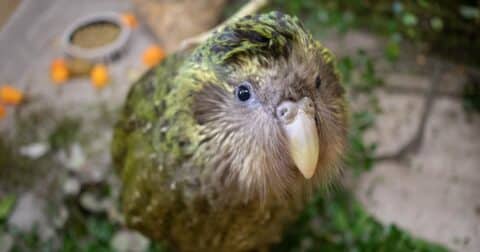Explainer
How Overconsumption Affects the Environment and Health, Explained
Climate•12 min read
Explainer
Deforestation, commercial fishing and climate change threaten these endangered animals.


Words by Seth Millstein
There have been five mass extinctions in Earth’s history. Now, many scientists say that we’re in the midst of a sixth mass extinction. Described by some scientists as a “rapid mutilation of the tree of life,” various human activities over the last 500 years have caused plants, insects and animals to go extinct at an alarming rate.
A mass extinction is when 75 percent of the Earth’s species go extinct over the course of 2.8 million years. Past extinctions have been due to one-off events, like volcanic eruptions and asteroid impacts, or naturally-occurring processes, like rising sea levels and shifting atmospheric temperatures. The present mass extinction is unique in that it’s being driven primarily by human activities.
A 2023 Stanford study found that since 1500 AD, entire genuses have been going extinct at a rate 35 times higher than in the preceding million years. This accelerated extinction, the authors of the study wrote, isn’t only hurting the planet — it’s also “destroying the conditions that make human life possible.”
Out of all the species that have ever existed on Earth, 98 percent are already extinct. Since the Industrial Revolution, however, humans have been extracting Earth’s resources, repurposing its land and polluting its atmosphere at an accelerated rate.
Between 1850 and 2022, yearly greenhouse emissions have increased tenfold; we’ve converted around half of the world’s habitable land to agriculture, and destroyed one-third of all forests since the end of the last Ice Age 10,000 years ago.
All of this hurts animals in various ways. Deforestation is particularly damaging, though, as it destroys entire habitats that countless species rely on to survive. Our food systems bear much of the blame for this destruction, as agricultural development is the biggest driver of deforestation.
As many as 273 species may be going extinct every single day, according to one analysis. Some of the more recently declared extinct species include:
While it’s unfortunately too late for any of the aforementioned species, many other animals are still teetering on the brink of extinction, but still hanging on. Here are a few of them.
Saolas are a forest-dwelling relative of cattle who live exclusively in the mountains between Vietnam and Laos. Known for their long, straight horns and distinctive white facial markings, saola were first discovered in 1992, and it’s estimated that there are only between a couple dozen and a couple hundred of them remaining.
The North Atlantic right whale was hunted to the brink of extinction by commercial whalers in the late 19th century. An international agreement in 1935 banned the hunting of all right whales, but collisions with ships and entanglements in fishing gear have prevented their population from rebounding. It’s estimated that there are around 360 North Atlantic right whales remaining.
The Gharial is a type of crocodile with a thin, elongated snout and protruding, bulbous eyes. Though once scattered throughout India, Bangladesh, Myanmar and several other south Asian countries, the gharial population has fallen by 98 percent since the 1940s, and they’re now found only in select regions of Nepal and northern India.
Hunting, overfishing of gharial prey, accidental trappings in fishing nets and agricultural development of grazing land are but a few of the human activities that have contributed to the gharial’s declining numbers.
A nocturnal, flightless parrot native to New Zealand, the kākāpō is believed to have one of the longest lifespans of any bird, with some reportedly living up to 90 years. Unfortunately, they also have a lot of things working against them, including low genetic diversity, ineffective defenses against mammalian predators and infrequent breeding seasons.
In the 1990s, there were only 50 kākāpō remaining, but aggressive conservation efforts have brought the population to over 250.
The Amur leopard is the rarest large cat in the world, with estimates pegging the remaining population at less than 200. They live exclusively in the Russian Far East and neighboring areas of northeast China, and as apex predators, they play an important ecological role by helping maintain the balance of local species and wildlife. Unfortunately, they’ve nearly been wiped out by hunting, logging, industrial development and other human activities.
The vaquita is a small porpoise who lives in the northern Gulf of California in Mexico. Though there were around 600 of them as late as 1997, there are now only 10 vaquitas left on Earth, making them one of the rarest animals on the planet.
The only known reason for their population decline is fishing nets; though vaquitas themselves aren’t fished, they often get caught in gillnets intended to trap totoaba fish — which is itself an endangered species that’s illegal to sell or trade.
The black rhino was once ubiquitous in Africa, with some estimates putting their population at one million in 1900. Unfortunately, aggressive hunting by European colonizers in the 20th century caused their population to plummet, and by 1995, only 2,400 black rhinos remained.
Thanks to relentless and dogged conservation efforts throughout Africa, however, the black rhino population has rebounded significantly, and there are now over 6,000 of them.
The northern white rhino, unfortunately, has not been as lucky as its black counterpart. The species is functionally extinct, as the only two remaining members of the species are both female. They live at the Ol Pejeta Conservancy in Kenya, and are protected by armed guards 24 hours a day.
There is, however, a small beacon of hope for the northern white rhino. By combining eggs from the two remaining female northern white rhinos with sperm that was collected from the males before they all died, conservationists have created new northern white rhino embryos. They hope to revive the species by implanting those embryos in southern white rhinos, as the two subspecies are genetically similar.
A subspecies of the western lowland gorilla, the cross river gorilla is the rarest of the great apes, with researchers estimating that only 200 to 300 still exist. Hunting, poaching and deforestation are the primary reasons for their decline. Once believed to be extinct, cross river gorillas now live exclusively in the forests on the Nigerian-Cameroonian border.
Known for their ornate shell patterns and long, beak-like noses, hawksbill sea turtles dine solely on sponges, which makes them indispensable in maintaining the ecosystems of coral reefs.
However, their population has declined by 80 percent in the last century, largely due to poachers seeking their beautiful shells. While hawksbill sea turtles were once believed to live exclusively in coral reefs, they’ve more recently been spotted in mangroves in the Eastern Pacific as well.
As their name suggests, Vancouver Island marmots are found on Vancouver Island — and only on Vancouver Island. In 2003, there were fewer than 30 of them remaining, but thanks to aggressive and ongoing efforts by conservationists, their population has rebounded significantly, and there are now around 300 of them.
However, they’re still critically endangered. The main threats that they face are predation by cougars and diminishing snowpack due to global warming, which threatens the vegetation that they eat.
In just one generation, Sumatran elephants lost 50 percent of their population and 69 percent of their habitat. The primary causes of their decline are deforestation, agricultural development, poaching and other conflicts with humans.
Sumatran elephants need to eat over 300 pounds of foliage every day, but because so much of their habitat has been destroyed, they often wander into villages and other human settlements in search of food, leading to violence on both sides.
There are three species of orangutan, and all of them are critically endangered. The Bornean orangutan in particular has lost 80 percent of its habitat in the last 20 years, in large part due to deforestation by palm oil producers, while the Sumatran orangutan population has fallen by 80 percent since the 1970s. In addition to deforestation, orangutans are often hunted for their meat, or captured as infants and kept as pets.
Scientists have warned that, in the absence of swift and decisive action to fight climate change and environmental destruction, up to 37 percent of all species could go extinct by 2050. The current rate at which species are going extinct, according to the authors of the Stanford study, presents an “irreversible threat to the persistence of civilization.”
Earth is a complex and interlocking ecosystem, and our fates as humans are linked to the fates of all the other species with whom we share the planet. The dizzying rate at which animals are going extinct isn’t just bad for those animals. It is, potentially, very bad news for us as well.